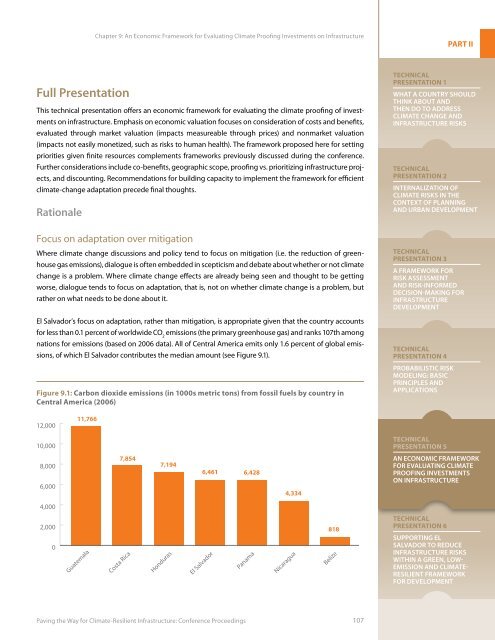Paving the Way for Climate-Resilient Infrastructure - UN CC:Learn
Paving the Way for Climate-Resilient Infrastructure - UN CC:Learn
Paving the Way for Climate-Resilient Infrastructure - UN CC:Learn
You also want an ePaper? Increase the reach of your titles
YUMPU automatically turns print PDFs into web optimized ePapers that Google loves.
Chapter 9: An Economic Framework <strong>for</strong> Evaluating <strong>Climate</strong> Proofing Investments on <strong>Infrastructure</strong>PART IIFull PresentationThis technical presentation offers an economic framework <strong>for</strong> evaluating <strong>the</strong> climate proofing of investmentson infrastructure. Emphasis on economic valuation focuses on consideration of costs and benefits,evaluated through market valuation (impacts measureable through prices) and nonmarket valuation(impacts not easily monetized, such as risks to human health). The framework proposed here <strong>for</strong> settingpriorities given finite resources complements frameworks previously discussed during <strong>the</strong> conference.Fur<strong>the</strong>r considerations include co-benefits, geographic scope, proofing vs. prioritizing infrastructure projects,and discounting. Recommendations <strong>for</strong> building capacity to implement <strong>the</strong> framework <strong>for</strong> efficientclimate-change adaptation precede final thoughts.RationaleFocus on adaptation over mitigationWhere climate change discussions and policy tend to focus on mitigation (i.e. <strong>the</strong> reduction of greenhousegas emissions), dialogue is often embedded in scepticism and debate about whe<strong>the</strong>r or not climatechange is a problem. Where climate change effects are already being seen and thought to be gettingworse, dialogue tends to focus on adaptation, that is, not on whe<strong>the</strong>r climate change is a problem, butra<strong>the</strong>r on what needs to be done about it.El Salvador’s focus on adaptation, ra<strong>the</strong>r than mitigation, is appropriate given that <strong>the</strong> country accounts<strong>for</strong> less than 0.1 percent of worldwide CO 2emissions (<strong>the</strong> primary greenhouse gas) and ranks 107th amongnations <strong>for</strong> emissions (based on 2006 data). All of Central America emits only 1.6 percent of global emissions,of which El Salvador contributes <strong>the</strong> median amount (see Figure 9.1).Figure 9.1: Carbon dioxide emissions (in 1000s metric tons) from fossil fuels by country inCentral America (2006)TechnicalPresentation 1What a Country ShouldThink About andThen Do to Address<strong>Climate</strong> Change and<strong>Infrastructure</strong> RisksTechnicalPresentation 2Internalization of<strong>Climate</strong> Risks in <strong>the</strong>Context of Planningand Urban DevelopmentTechnicalPresentation 3A Framework <strong>for</strong>Risk Assessmentand Risk-In<strong>for</strong>medDecision-Making <strong>for</strong><strong>Infrastructure</strong>DevelopmentTechnicalPresentation 4Probabilistic RiskModeling: BasicPrinciples andApplications12,00011,76610,000TechnicalPresentation 58,0006,0007,8547,1946,461 6,4284,334An Economic Framework<strong>for</strong> Evaluating <strong>Climate</strong>Proofing Investmentson <strong>Infrastructure</strong>4,0002,0000GuatemalaCosta RicaHondurasEl SalvadorPanamaNicaragua818BelizeTechnicalPresentation 6Supporting ElSalvador to Reduce<strong>Infrastructure</strong> Riskswithin a Green, Low-Emission and <strong>Climate</strong>-<strong>Resilient</strong> Framework<strong>for</strong> Development<strong>Paving</strong> <strong>the</strong> <strong>Way</strong> <strong>for</strong> <strong>Climate</strong>-<strong>Resilient</strong> <strong>Infrastructure</strong>: Conference Proceedings 107Guatemala 11,766Costa Rica 7,854
















